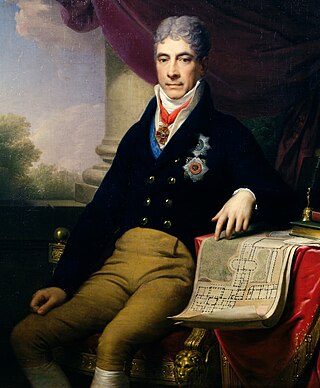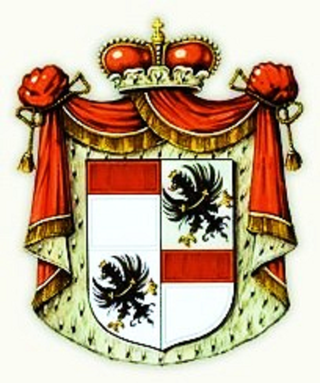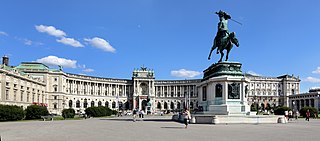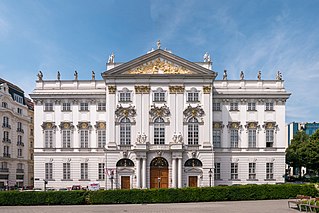
Count Andrey Kirillovich Razumovsky was a Russian Imperial diplomat who spent many years of his life in Vienna. His name is transliterated differently in different English sources, including spellings Razumovsky, Rasumofsky, and Rasoumoffsky.

Johann Bernhard Fischer von Erlach was an Austrian architect, sculptor, engraver, and architectural historian whose Baroque architecture profoundly influenced and shaped the tastes of the Habsburg Empire. His influential book A Plan of Civil and Historical Architecture (1721) was one of the first and most popular comparative studies of world architecture. His major works include Schönbrunn Palace, Karlskirche, and the Austrian National Library in Vienna, and Schloss Klessheim, Holy Trinity Church, and the Kollegienkirche in Salzburg.

The House of Lobkowicz is a Czech noble family that dates back to the 14th century and is one of the oldest Bohemian noble families. The family also belongs to the German, Austrian and Belgian nobility. The first Lobkowiczs were members of the gentry of north-eastern Bohemia in the late 14th century. The family's Imperial immediacy over Princely county of Störnstein was mediatized by Bavaria in 1807. As such, the House of Lobkowicz belong to the small group of families that constitute the Hochadel and is one of the mediatised houses.

The Hofburg is the former principal imperial palace of the Habsburg dynasty. Located in the centre of Vienna, it was built in the 13th century and expanded several times afterwards. It also served as the imperial winter residence, as Schönbrunn Palace was the summer residence. Since 1946, it is the official residence and workplace of the president of Austria.

Johann Lukas von Hildebrandt was an Austrian baroque architect and military engineer who designed stately buildings and churches and whose work had a profound influence on the architecture of the Habsburg Empire in the eighteenth century. After studying in Rome under Carlo Fontana, he constructed fortresses for Prince Eugene of Savoy during his Italian campaigns, becoming his favorite architect. In 1700 he became court engineer in Vienna, and in 1711 was named head of the court department of building. He became court architect in 1723. His designs for palaces, estates, gardens, churches, chapels, and villas were widely imitated, and his architectural principles spread throughout central and southeast Europe. Among his more important works are Palais Schwarzenberg, St. Peter's Church, and Belvedere in Vienna, Savoy Castle in Ráckeve, Schönborn Palace in Göllersdorf, and Schloss Hof.

Palais Rothschild refers to a number of palaces in Vienna, Austria, which were owned by members of the Austrian branch of the Rothschild banking family. Apart from their sheer size and elegance, they were famous for the huge collections of valuable paintings, statues, furniture, books and armour that they housed, another reflection of the family's vast wealth and prominent position.

Palais Trautson is a Baroque palace in Vienna, Austria, located at Museumstraße 7. It was once owned by the noble Trautson family.

Palais Schwarzenberg is a Baroque palace in front of Schwarzenbergplatz, Landstraße, the 3rd district of Vienna, Austria. It is owned by the princely Schwarzenberg family.

Palais Augarten is a Baroque palace in the district of Leopoldstadt, Vienna, Austria. Constructed in the late seventeenth century by Johann Bernhard Fischer von Erlach on the site of a Jagdschloss and gardens, the palace and gardens were expanded in the nineteenth century under Emperor Franz Joseph I of Austria. Despite extensive damage suffered during World War II, the palace has been maintained almost in its original appearance, and many of the original furnishings can still be found there. Today, Palais Augarten is the home and rehearsal space of the Vienna Boys' Choir, who also have their own school there. The palace is located in the 130-acre Augarten park, which is the oldest Baroque garden in Vienna.

Palais Schönborn-Batthyány is a Baroque palace in the Innere Stadt district of Vienna, Austria.

Palais Kinsky is a Baroque palace in central Vienna, Austria. It was originally built for Count Wirich Philipp von Daun, the garrison commander whose son Leopold became a Field Marshal of Empress Maria Theresa. The palace was later bought by the Kinsky family of Bohemia, and it is sometimes called the Palais Daun-Kinsky.

Joseph Emanuel Fischer von Erlach, also Fischer von Erlach the Younger was an Austrian architect of the Baroque, Rococo, and Baroque-Neoclassical.

The Theatermuseum is a federal museum of national theatre history. Since 1991 it is situated in the Palais Lobkowitz in Vienna.

The Lobkowicz Palace is a part of the Prague Castle complex in Prague, Czech Republic. It is the only privately owned building in the Prague Castle complex and houses the Lobkowicz Collections and Museum.
Eroica is a BBC television film that dramatises the first performance of Beethoven's third symphony, the Eroica. It carries the tagline 'The day that changed music forever'.

The Winter Palace of Prince Eugene, also known as the City Palace, is a high-Baroque palace in the Innere Stadt district of Vienna, Austria. Located on a narrow street at Himmelpfortgasse 8, the palace was used as the winter residence of Prince Eugene of Savoy, who spent his summers at the Belvedere. The Winter Palace was designed and constructed by Johann Bernhard Fischer von Erlach from 1695 to 1700, and by Johann Lukas von Hildebrandt from 1702 to 1724 following his predecessor's plans.

Joseph Franz Maximilian, 7th Prince of Lobkowitz was an aristocrat of Bohemia, from the House of Lobkowicz. He is known particularly for his interest in music and as a patron of Ludwig van Beethoven.
The Neupauer-Breuner Palace, known in German as Palais Neupauer-Breuner and sometimes referred to only as Palais Breuner by locals, is a Baroque building situated at Singerstrasse 16 in the first district of Vienna in Austria.

The Palais Erzherzog Ludwig Viktor is one of the best known Ringstraßenpalais in Vienna. It was built between 1863 and 1866. The first building to be built on the Schwarzenbergplatz, it is now a subsidiary house of the Burgtheater.

The Michaelerplatz is a major square in the center of Vienna. It is a baroque, star-shaped square that functions as the point of intersection of several inner-city streets – the Kohlmarkt, the Herrengasse, the Schauflergasse, and the Reitschulgasse – as well as the northeast entry point to the Hofburg. The square is named after St. Michael's Church, which lies on the eastern part of the Michaelerplatz.


















